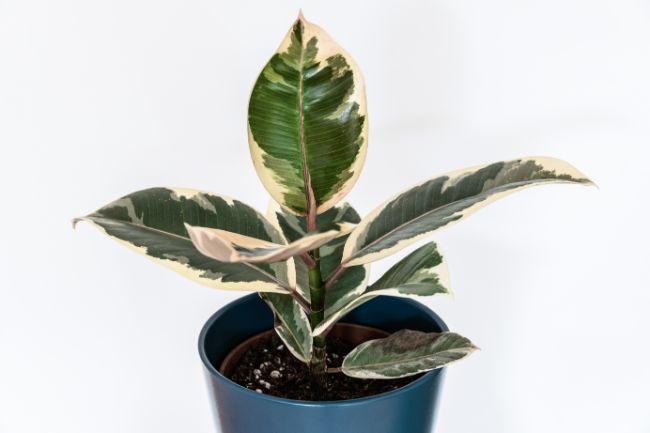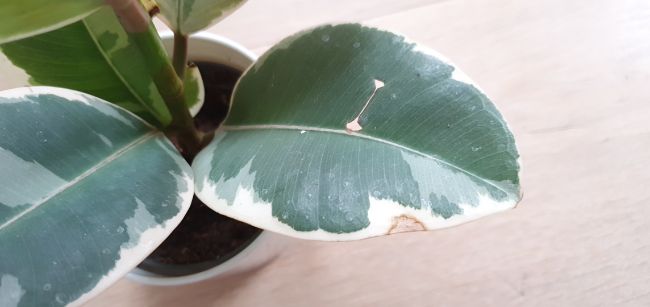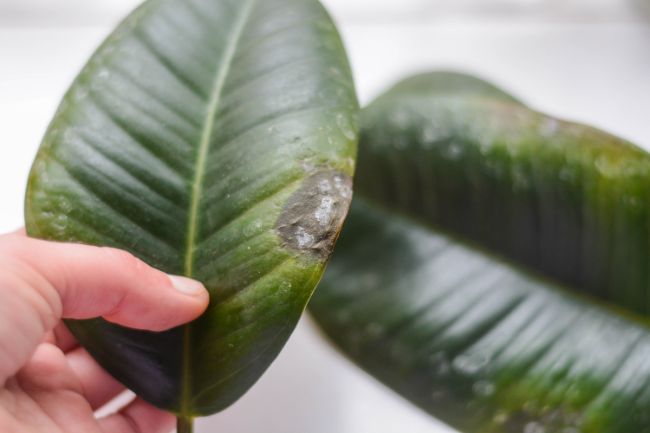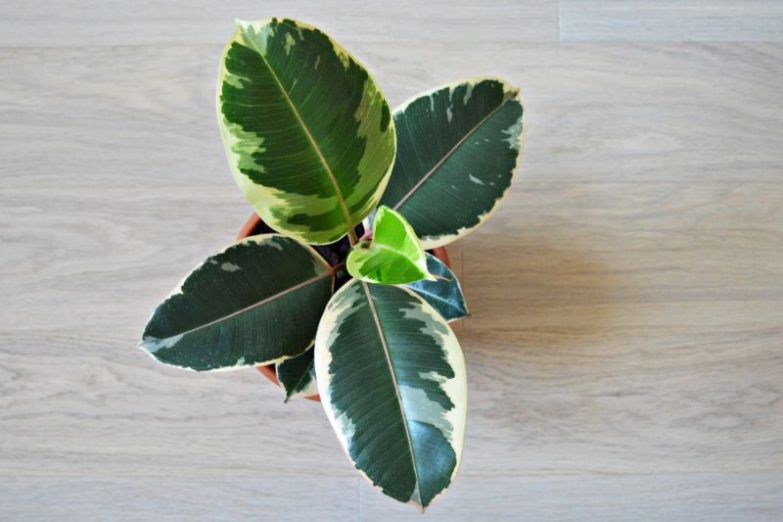The Rubber Plant is a classic favorite known for its bold and distinctive foliage. Unfortunately, their handsome leaves can develop brown areas from a number of issues. Let’s look at why your Rubber Plant’s leaves are turning brown and how to fix the problem.
Rubber Plant leaves turning brown is most commonly due to sunburn, old foliage, or issues with watering. Many other problems can cause leaf browning also. It is essential to examine your plant and the care conditions to work out the cause before trying to fix the cause of brown leaves.
Overview Of The Rubber Plant (Ficus Elastica)
The Rubber Plant has been popular since the Victorian era and is still in high demand for its beauty, character, and personality. Stress can cause unattractive leaf discoloration in what is often a high-visibility plant.
It stays relatively tame in a pot, but a Rubber Plant can grow into an immense tree in the ground outdoors. The bold, rugged leaves are largest when the plant is young and shrink with maturity.
This is very much a tropical plant: it likes moist soil and indirect bright light. Finding brown areas on your Rubber Plant’s foliage should initiate an evaluation of its care.
The plant is easy to keep if you avoid overwatering! Rubber Plants are far from being succulents, but they do have some tolerance for dry spells. Let them dry out slightly between waterings to let their roots breathe.
Sadly, brown leaves won’t return to health. The good news is the plant can grow quickly to replace the damage once the problem is remedied.
Why Your Rubber Plant’s Leaves Are Turning Brown
It’s important to find the reason your Rubber Plant’s leaves are turning brown and address the issue appropriately. Sometimes there’s more than one cause: it’s a good idea to scan the possible reasons and make needed adjustments.
Natural Aging
Old leaves eventually turn brown and die. It’s inevitable and normal – only if it becomes frequent or affects multiple leaves is there cause for concern.
Lower leaves are generally the oldest and therefore shed most often … seeing brown leaves at the top of the plant may signal an issue beyond routine aging.
Even though this kind of loss is natural, it’s a good reminder to reevaluate the plant’s health. Sometimes a struggling plant will drop old leaves to concentrate on new growth.

Sunburn
This cause is usually easy to diagnose. Overexposure to sunlight or even intense artificial rays can turn the leaves brown or give them scorched spots. The simple solution is to remove or protect your Rubber Plant from overexposure. Read my article on houseplant light requirements if you’re not sure where to put your plant.
Be attentive to changes of season. A west-facing window that gets mild afternoon light could become a blazing hotbox as the sun’s position changes.
The brown spots and leaves won’t recover and can be safely trimmed. You may prefer to leave partly damaged foliage in place to continue producing energy for the plant.
Overwatering
It’s very important to check the soil if you see your Rubber Plant’s leaves turning brown. Overwatering encourages deadly root rot – which in its terminal phases causes dead, brown leaves – so hold off on watering if you have any doubts.
A combination of generally yellowing leaves, with browning tips is a classical sign of overwatering, and should be addressed immediately.
The reason the medium should never be overly wet is that decay pathogens thrive in sodden, low-oxygen environment: for example, a container of water-logged soil.
If you suspect overwatering is the cause of brown leaves on your Rubber Plant, unpot the victim and inspect the root system:
- Healthy roots are firm and white or pale; they have an earthy scent.
- Rotting roots are brown or black, mushy, and smell foul. If the rot hasn’t proceeded too far, you can try to save the plant … it’s far better not to let the situation get so far.
It’s important to remember that it’s not just watering too frequently that will create soggy conditions, but using poorly draining soil or a pot without drainage holes will have the same result.
Also bear in mind that low light conditions will cause your Rubber Plant to grow more slowly and use less water, increasing the risk of root rot. If you think your Rubber Plant has root rot, read my article covering how to save your plant from this common problem.
Underwatering
If your Rubber Plant’s leaves have developed brown crispy areas, particularly at the tips and edges, you may not be watering enough. It is common for gardeners who realize the dangers of overwatering to err in the other direction.
Also, a highly rootbound plant may not be receiving adequate water because the roots have replaced the soil.
Ensure the root ball is well saturated when you water. Soil that contains a lot of peat may be difficult to rehydrate once it’s dried, so extra soaking might be necessary.
Soil Mix
Soil composition is a big component of proper watering. A heavy, holding mix risks being wet for too long … at the other extreme, a light, fast-draining medium may dry too quickly.
The best soil for a Rubber Plant has organic content for fertility and water retention, with additional inert aerating materials like bark, coarse sand, pumice, or perlite to allow ample drainage.
A perfect potting mix for Rubber Plants that I like to use consists of the following;
- 2/3 houseplant potting mix (link to Amazon)
- 1/3 perlite (link to Amazon)
If soil isn’t ideal, learn to work around its limitations.
- A light, quickly draining mix needs to be watered more frequently.
- Flushing the soil at watering time is normally the best practice – but heavy soils are an exception. Monitor often and water more sparingly without soaking the soil. Increase ventilation to help dry out the mix.
Note: Reduce watering over the late fall and winter months.
If your Rubber Plant has brown leaves, and you think the soil is part of the problem, I would hugely recommend repotting your plant into more suitable soil. Whilst you can certainly grow a healthy plant in imperfect conditions, it just makes things so much easier when the conditions suit the plant.

Water Impurities
Tapwater with a high level of minerals or chemicals can result in your Rubber Plant leaves turning brown, most notably with brown leaf spots and brown tips. The plant’s life is generally not in danger unless the problem becomes extreme.
If your tapwater is heavily mineralized, use only pure or filtered water on the plant for a time to see if it makes a difference. If you’d like to know whether to switch to something other than tapwater for your plants, this article will walk you through the options.
Be aware that contaminants in the soil may also include unused fertilizer or other residual chemicals, and that these can build up and become toxic over time. If possible, flush the soil every watering to cleanse the buildup of residual toxins. Simply run an excess of water through the pot. Let it drain and optionally repeat.
If the soil is heavy and would remain too wet if thoroughly inundated, do a monthly or quarterly flush instead.
Temperature
Temperature stress can result in your Rubber Plant leaves turning brown. Rubber Plants are tender tropicals that start to suffer as the thermometer drops much below 55°F (°13C).
- Don’t subject the plant to rapid changes in temperature.
- Keep them out of drafts.
- Move them safely away from heaters or fireplaces.
Nutrition
It’s easy to overfertilize a Rubber Plant; although the plant likes fertile soil, it isn’t a heavy feeder. Too much fertilizer can burn their tender roots and cause dry, browning leaves; the tips often show damage first. (A buildup of fertilizer residue over time can cause the same effect.)
The solution to overfertilization is to flush the soil thoroughly to dilute the fertilizer salts. Don’t add fertilizer until you see new growth.
Underfertilization may indirectly cause brown foliage, but undernourished leaves tend to look sickly yellow before turning brown. If you decide your plant needs a boost, just remember that a little goes a long way.
I prefer to use a balanced, water-soluble fertilizer on my Rubber Plants, but I’m careful to dilute it to only half the recommended strength to avoid the risk of fertilizer burn. This is the one I use (link to Amazon).
You can read more about the options for fertilizing your houseplants in this article.
Humidity
Rubber Plants come from humid tropical areas, but they are usually tolerant of average conditions if they’re properly watered. Low humidity may stress the plant, however, which can trigger increased leaf browning and loss.
If your humidity is low and your plant looks lackluster, you can bump the level slightly by placing pebble-filled water trays nearby. The friendly Rubber Plant isn’t one to demand a room humidifier, but it wouldn’t say no.
Note that winter can be hard on plants as artificial heating drives moisture from the air. This may explain seasonal browning, too. If your plant is struggling over the winter, it will probably benefit from extra humidity. This article explains the best ways to increase humidity for your houseplants.
Acclimation To A Move or Repotting
After a serious disruption to their environment, a Rubber Plant will need some repair time. You may see your Rubber Plant leaves turning brown, or even dropping during recuperation, but give the plant steady good care and it will bounce back.
Pests
Pest damage shows up as mottled or deformed foliage that eventually turns brown and dies. Rubber Plants aren’t particularly vulnerable to pests, but they do seem to attract scale – small, legless insects that love the plant’s many nooks and crannies. The round-shelled tiny bumps are easy to miss: an infestation can seem like part of the plant.
Note: Try wiping isopropyl (rubbing) alcohol on a suspicious area … if color comes off, it wasn’t part of the plant!
A good way to keep pest infestations from becoming well established is to routinely clean and inspect the leaves. This not only prevents infestations, it keeps the leaves glossy and breathing freely.

Disease
A healthy Rubber Plant is resilient against disease, so the best prevention is to ensure the plant’s conditions and care regimen are adequate. The first symptoms of disease are usually areas of leaf mottling or discoloration, but disease can definitely cause browning as it progresses.
The most common ailment is a fungal infection that often leaves white deposits. This frequently happens in humid or wet conditions. Most fungal invasions aren’t fatal and will respond to a reduction in moisture. Much of the time, simply trimming away affected leaves and being careful with watering is enough to curb an infection.
Last Word
If you’ve noticed your Rubber Plant leaves turning brown, it’s important to think carefully about why it has happened. The good news is that if you look at the conditions your plant has been growing in, and think about what your plant has recently experienced, it is almost always possible to identify the problem.
Once you think you know what the issue is, fixing the problem isn’t too hard. Hopefully you’ll not only restore your plant to health, but also learn to avoid similar problems with your other plants.
If you’d like to learn more about Rubber Plant problems, and essential houseplant care, check out the following articles.
- How to care for a Rubber Plant.
- How to stop your Rubber Plant from losing leaves.
- How to fix curling leaves on your Rubber Plant.
- How to prune a Rubber Plant.
- Ficus diseases and treatments.
- How to prevent and fix yellow leaves on your Rubber Plant.
- 25 hard to kill houseplants that look fantastic.
- Check out my book, “Houseplants Made Easy”.

